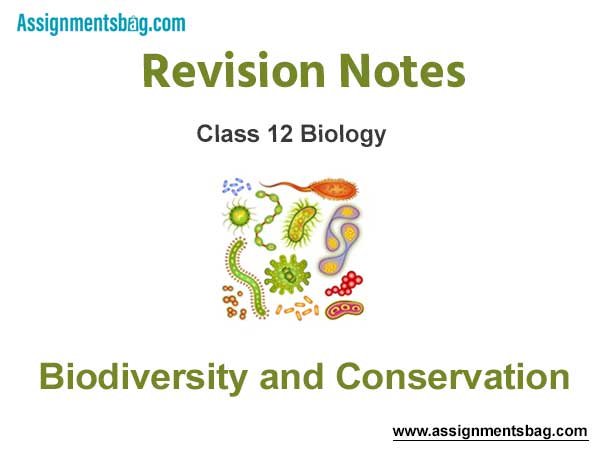Please refer to Biodiversity and Conservation Class 12 Biology Revision Notes for Chapter 14 provided below. These concept notes have been prepared based on the latest Class 12 Biology NCERT, CBSE, and KVS books issued for the current academic year. These notes will help you to learn all important topics given in the chapter and are important to get good marks. We have provided Class 11 Biology Notes for all chapters on our website for download in Pdf.
Class 12 Biology Chapter 15 Biodiversity and Conservation Revision Notes
- Biodiversity (Gk bios = life, diversity = forms) or biological diversity can be defined as the vast array of species of microorganisms, algae, fungi, plants and animals occurring on the earth either in the terrestrial or aquatic habitats and the ecological complexes of which they are a part. This includes diversity within species, between species and of the ecosystem.
- India has 10 biogeographical regions namely, Trans Himalayas, Himalayas, Desert, Semi-Arid, Western Ghats, Deccan Peninsula, Gangetic Plain, Coasts, North-East and Islands. The country is rich in endemic flora and fauna. The richest regions are the Himalayas, Western Ghats, Indian Islands and North-Eastern Hills of India. Each biogeographical region has several habitats, biotic communities and ecosystems. The largest biogeographical region is Deccan Peninsula and the most biodiversity rich regions are Western Ghats and North-East.

Ecosystem diversity is of 3 types :
- Alpha (α) diversity (within community diversity) refers to the diversity of organisms i.e., number of species in given community or habitat. It is calculated by the combination of species richness and evenness or equitability.
- Beta (β) diversity (between community diversity) is diversity which develops due to change in a habitat or community along environmental gradients like altitude, latitude, moisture gradient, etc. The greater the difference or turnover of species between the habitats, the greater is the beta-diversity.
- Gamma (γ) diversity is also called regional diversity. It represents the total richness of species in all the habitats found within a region, geographical area or landscape. When each habitat has a unique biota, gamma diversity is equal to average alpha diversity multiplied by the number of such habitats.
PATTERNS OF BIODIVERSITY
- Latitude and Altitude Gradient
(i) Species diversity decreases as we move away from the equator towards the poles. It increases in temperate areas but reaches the maximum in tropical rain forests. Maximum diversity occurs in Amazon rain forest of South America.
(ii) Tropics account for greater biological diversity.
(iii) Reasons behind the maximum biological diversity in tropical regions are:
- Prolong evolutionary time : Speciation is generally a function of time, unlike temperate regions subjected to frequent glaciations in the past, tropical latitudes have remained relatively undisturbed for millions of years and thus, had a long evolutionary time for species diversification.
- Constant environment : Tropical environments, unlike temperate ones, are less seasonal, relatively more constant and predictable. Such constant environments promote niche specialisation and lead to a greater species diversity.
- High productivity : There is more solar energy available in the tropics, which contributes to higher productivity; this in turn, might contribute indirectly to greater diversity.
Species Area Relationships
- Within a region, the species richness increases with increasing area but upto a certain limit. The relationship between species richness and area is a rectangular hyperbola for a wide variety of taxa whether they are birds, bats, fresh water fishes or flowering plants.
- On a logarithmic scale it is a straight line.
(i) log S = log C + Z log A
(ii) Here, S is species richness, Z is slope of line or regression coeficient, C is Y intercept while A is area.

- Regression coeficient is generally 0.1–0.2 regardless of taxonomic group or region. However, when the species-area relationship is considered for a very large area like a whole continent, regression coeficient or slope of the line comes to have Z value of 0.6–1.2, e.g., for frugivorous birds and mammals of tropical forests of different continents, the slope is found to be 1.15.

Importance of species diversity to ecosystem can be explained by :
(i) Productivity-s tability hypothesis : David Tilman found that areas with more species showed less year to year variation in total biomass. He experimentally showed that, increased diversity contributed to higher productivity.
(ii) Diversity-stability hypothesis : According to Johnson et al 1996, the ecological communities will decrease in ability to recover from disturbance and in productivity if there is reduction in species richness.
(iii) Rivet popper hypothesis : According to this hypothesis proposed by Stanford ecologist Paul Ehrlich (1981), the relationship between species richness and ecosystem functioning is non-linear, but may follow a variety of possible trajectories. The loss of a few species (or rivets holding together an aeroplane) will initially create no problem, but beyond a certain point losses will cause catastrophic effect.
LOSS OF BIODIVERSITY
The most serious aspect of the loss of biodiversity is the extinction of species. Extinction is of three types – natural extinction, mass extinction and anthropogenic extinction. Natural or background extinction is a slow process of replacement of existing species with the better adapted species due to alternate evolution, changes in environmental conditions, predators and diseases. Earth has experienced five mass extinctions due to environmental catastrophes. Anthropogenic extinctions are extinctions abetted by human activities like settlements, hunting, over exploitation and habitat destruction.
Red Data Book and IUCN
IUCN is International Union of Conservation of Nature and Natural Resources which is now called World Conservation Union (WCU). It maintains a red data book or red list which is a catalogue of taxa facing risk of extinction.

CONSERVATION OF BIODIVERSITY
There are three main reasons to conserve the biological diversity which can be grouped in three categories :
(i) Narrowly Utilitarian-useful human products like food, fibres, drugs and medicine, etc
(ii) Broadly Utilitarian-ecosystem services like provision of pollinators, climate regulation, flood and erosion control, ecological balance through nutrient cycling, etc.
(iii) Ethical Utilitarian-every living species has an intrinsic value though it may not have any direct economic value, and also, every species has a right to live.

Methods of biodiversity conservation
| In situ conservation | Hotspots | Protected areas |
| In situ (on site) is conservation and protection of the whole ecosystem and its biodiversity at all levels in order to protect the threatened species. Two methods are being used to save biodiversity, hot spots and protected areas. | Biodiversity hotspots are the areas characterised by very high levels of species richness, high degree of endemism and also accelerated habitat loss. Ecologically hotspots are determined by four factors as: number of species/ species diversity; degree of endemism; degree of threat to habitat due to its degradation and fragmentation; degree of exploitation. | National parks are large areas meant for the protection of flora and fauna and are maintained for scientific, educational and recreational use. They are not usually used for commercial extraction of resources. Sanctuaries are tracts of land with or without lake where wild animals/fauna can take refuge without being hunted. Biosphere reserves are multipurpose protected areas which are meant for preserving genetic diversity in representative ecosystems of various natural biomes and unique biological communities. Sacred forests and lakes (= sacred groves) are forest patches around places of worship which are held in high esteem by tribal communities. E.g., Karnataka, Maharashtra, Rajasthan. |
| Ex situ conservation | Offsite collection | Gene banks |
| It is the conservation of threatened plants and animals outside their natural habitats. These include offsite collections and gene banks. | These are live collections of wild and domesticated species in botanical gardens, zoological parks, wildlife safari parks, arboreta, etc. | These are institutes that maintain stocks of viable seeds (seed banks), live growing plants (orchards), tissue culture and frozen germplasm (cryopreservation) with the whole range of genetic variability. |



